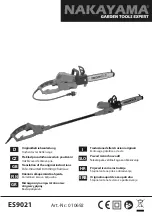
6
ENGLISH
(Original instructions)
f. Blade depth and bevel adjusting locking levers must
be tight and secure before making cut. If blade
adjustment shifts while cutting, it may cause binding and
kickback.
a. Use extra caution when sawing into existing walls or
other blind areas. The protruding blade may cut objects
that can cause kickback.
Lower guard function
a. Check lower guard for proper closing before each
use. Do not operate the saw if lower guard does not
move freely and close instantly. Never clamp or tie the
lower guard into the open position. If saw is
accidentally dropped, lower guard may be bent. Raise the
lower guard with the retracting handle and make sure it
moves
freely and does not touch the blade or any other part, in all
angles and depths of cut.
b. Check the operation of the lower guard spring. If the
guard and the spring are not operating properly, they
must be serviced before use. Lower guard may operate
sluggishly due to damaged parts, gummy deposits, or a
build-up of debris.
c. Lower guard may be retracted manually only for
special cuts such as "plunge cuts" and "compound
cuts". Raise lower guard by retracting handle and as soon
as blade enters the material, the lower guard must be
released. For all other sawing, the lower guard should
operate automatically.
d. Always observe that the lower guard is covering the
blade before placing saw down on bench or floor. An
unprotected, coasting blade will cause the saw to walk
backwards, cutting whatever is in its path. Be aware of the
time it takes for the blade to stop after switch is released.
Riving knife function
a. Use the appropriate saw blade for the riving knife. For
the riving knife to function, the body of the blade must be
thinner than the riving knife and the cutting width of the
blade must be wider than the thickness of the riving knife.
b. Adjust the riving knife as described in this instruction
manual. Incorrect spacing, positioning and alignment can
make the riving knife ineffective in preventing kickback.
c. Always use the riving knife except when plunge
cutting. Riving knife must be replaced after plunge
cutting. Riving knife causes interference during plunge
cutting and can create kickback.
d. For the riving knife to work, it must be engaged in the
workpiece. The riving knife is ineffective in preventing
kickback during short cuts.
e. Do not operate the saw if riving knife is bent. Even a
light interference can slow the closing rate of a guard.
Residual risks.
Additional residual risks may arise when using the tool which
may not be included in the enclosed safety warnings. These
risks can arise from misuse, prolonged use etc.
Even with the application of the relevant safety regulations
and the implementation of safety devices, certain residual
risks can not be avoided. These include:
u
Injuries caused by touching any rotating/moving parts.
u
Injuries caused when changing any parts, blades or ac-
cessories.
u
Injuries caused by prolonged use of a tool. When using
any tool for prolonged periods ensure you take regular
breaks.
u
Impairment of hearing.
u
Health hazards caused by breathing dust developed when
using your tool (example:- working with wood, especially
oak, beech and MDF.)
Saw blades
u
Do not use blades of larger or smaller diameter than
recommended. For the proper blade rating refer to the
technical data. Use only the blades specified in this
manual, complying with EN 847-1.
u
Warning! Never use abrasive wheels.
Safety of others
u
This appliance is not intended for use by persons (includ-
ing children) with reduced physical, sensory or mental
capabilities, or lack of experience and knowledge, unless
they have been given supervision or instruction concern-
ing use of the appliance by a person responsible for their
safety.
u
Children should be supervised to ensure that they do not
play with the appliance.
Vibration
The declared vibration emission values stated in the technical
data and the declaration of conformity have been measured
in accordance with a standard test method provided by
EN 60745 and may be used for comparing one tool with
another. The declared vibration emission value may also be
used in a preliminary assessment of exposure.
Warning! The vibration emission value during actual use of
the power tool can differ from the declared value depending
on the ways in which the tool is used. The vibration level may
increase above the level stated.
Summary of Contents for FME300
Page 1: ...www stanley eu FME300 ...
Page 2: ...2 A B C D 15 9 ...
Page 3: ...3 E F G ...






























